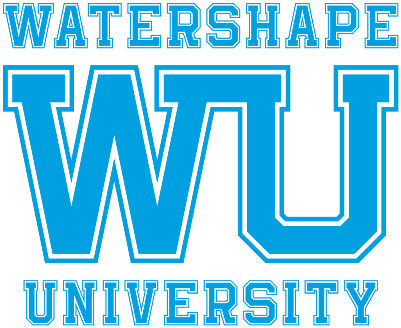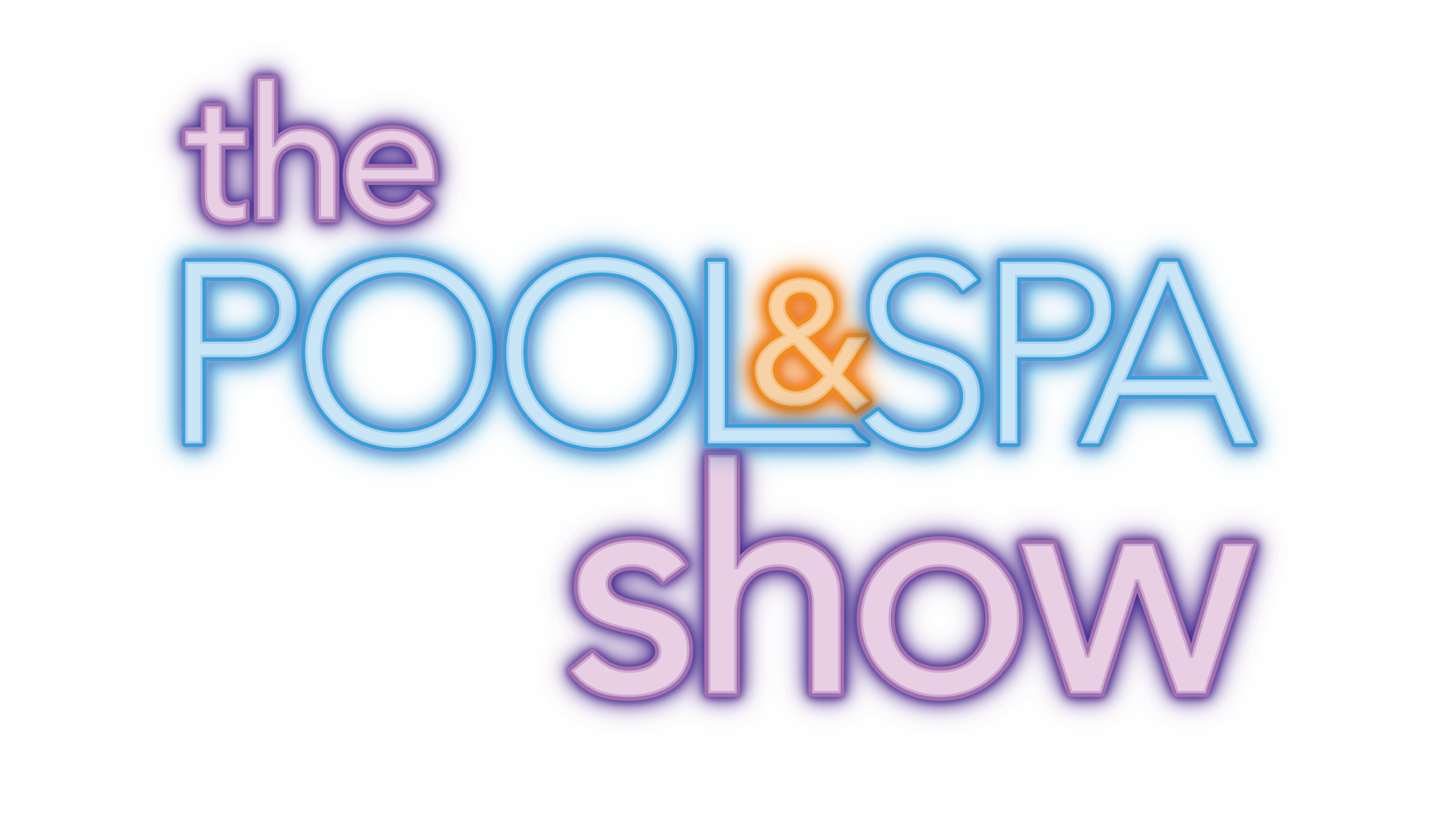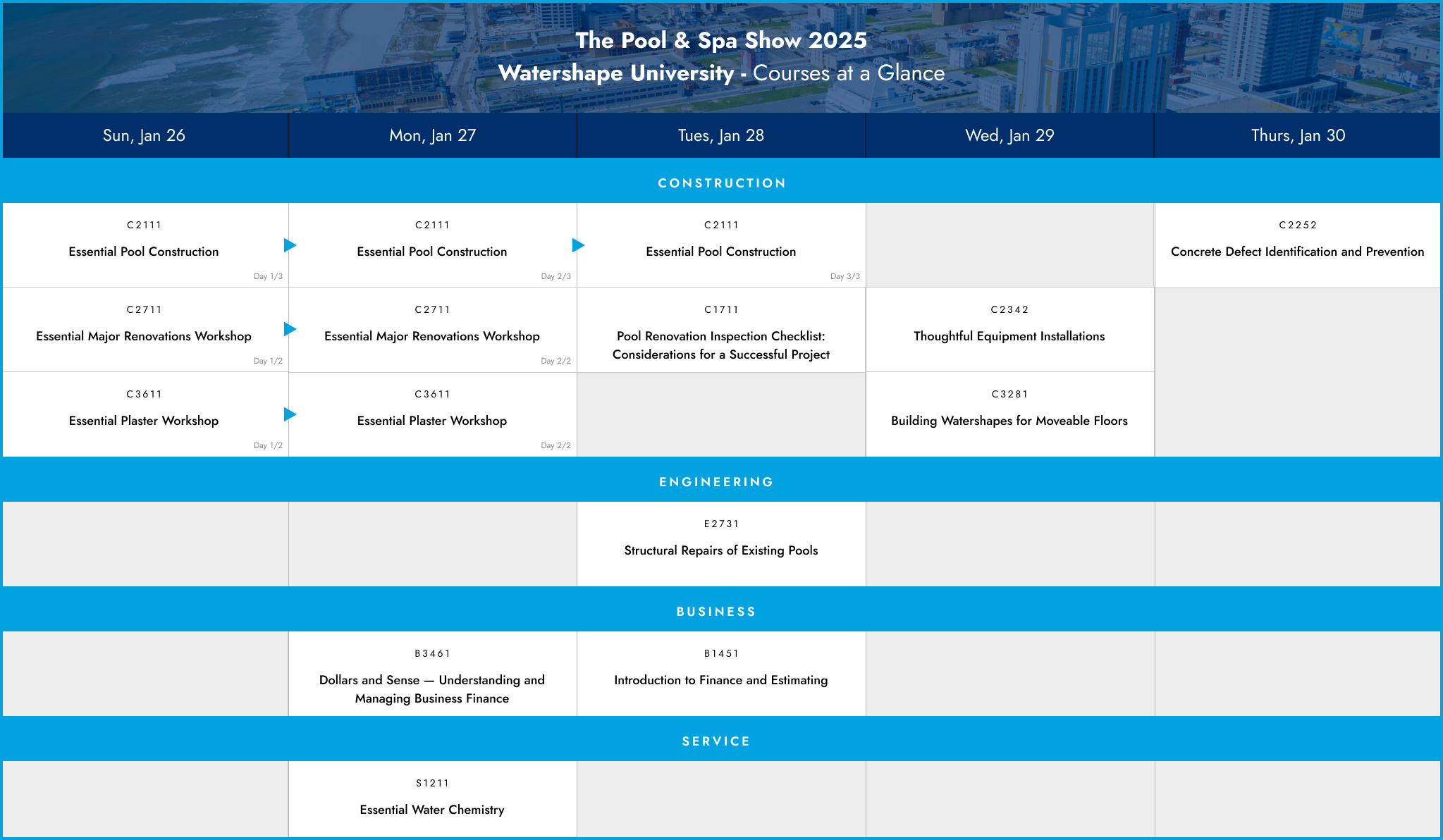Follow our social media for more updates on this event!
Itinerary
Sunday, January 26, 2025
8:00 AM to 5:00 PM: CONSTRUCTION 2111 – Essential Pool Construction (Day 1/3)
8:00 AM to 5:00 PM: CONSTRUCTION 2711 – Essential Major Renovations Workshop (Day 1/2)
8:00 AM to 5:00 PM: CONSTRUCTION 3611 – Essential Plaster Workshop (Day 1/2)
Monday, January 27, 2025
8:00 AM to 5:00 PM: CONSTRUCTION 2111 – Essential Pool Construction (Day 2/3)
8:00 AM to 5:00 PM: CONSTRUCTION 2711 – Essential Major Renovations Workshop (Day 2/2)
8:00 AM to 5:00 PM: CONSTRUCTION 3611 – Essential Plaster Workshop (Day 2/2)
8:00 AM to 5:00 PM: BUSINESS 3461 – Dollars and Sense — Understanding and Managing Business Finance
8:00 AM to 5:00 PM: SERVICE 1211 – Essential Water Chemistry
Tuesday, January 28, 2025
8:00 AM to 5:00 PM: CONSTRUCTION 2111 – Essential Pool Construction (Day 3/3)
Tuesday, January 28, 2025
9:00 AM to 10:30 AM: BUSINESS 1451 – Introduction to Finance and Estimating
9:00 AM to 10:30 AM: CONSTRUCTION 1711 – Pool Renovation Inspection Checklist: Considerations for a Successful Project
1:30 PM to 3:00 PM: ENGINEERING 2731 – Structural Repairs of Existing Pools
Wednesday, January 29, 2025
9:00 AM to 10:30 AM: CONSTRUCTION 2342 – Thoughtful Equipment Installations
1:30 PM to 3:00 PM: CONSTRUCTION 3281 – Building Watershapes for Moveable Floors
Thursday, January 30, 2025
8:30 AM – 10:00 AM: CONSTRUCTION 2252 – Concrete Defect Identification and Prevention
Program Summaries
Course Description
0.1 IACET CEUs
There are three primary reasons why construction companies have a disturbingly low rate of success (only 36/4% reach five years in business). Those factors include inadequate or inconsistent cash flow, overly rapid expansion (not turning down projects when they should), and low profit margins based on a failure to understand margins, markup, breakeven points, and accurate estimating. This online presentation touches on the basics of cost estimating and guides students toward improvements they should make in order to ensure long-term financial success.
Learning Objectives
- Examine overhead, profit, markup, gross margins.
- Evaluate profit-and-loss statements, and illustrate why many contractors fail financially.
- List and discuss payment scheduling, managing cash flow, expense management, and linking income to project progress.
- Review steps you can use to advance and enhance estimating capabilities.
Instructors
Donna Benedetti, MBA
Course Description
0.8 IACET CEUs
Financial success requires understanding the way money flows through your business, where and how it’s made, spent and invested. This course provides a blueprint for understanding and managing financial resources, with an eye toward implementing effective documentation, including profit/loss statements, balance sheets, project estimates, investment portfolios, and a range of other important financial components.
Learning Objectives
- Define key concepts including cash flow, overhead and profit.
- Examine managing key aspects of accounting and bookkeeping such as inventory, payables and receivables, and tax planning.
- Review elements of balance sheets, project estimates, operating costs, shareholder equity, as well as accelerated and amortized depreciation.
Instructors
Donna Benedetti, MBA
Chris Volk, IWI
Course Description
Renovation services are expected to be a major source of revenue when the next economic downturn slows new construction. But, establishing an accurate and thorough list of corrections and navigating the inherent risks is important to protect your company. What if you had the ultimate checklist to review while inspecting the project for the first time?
Learning Objectives
- List the structural, plumbing, electrical systems, and other components that need to be assessed during the first visit to the project site.
- Identify items that need to be rectified simply because of standard and code changes that have been implemented since the project was originally constructed.
- Discuss specific destructive and non-destructive tests that may be performed to gain insight into the performance of the project from a structural, hydraulic and electrical perspective.
Instructors
Paolo Benedetti, IWI
Course Description
2.4 IACET CEUs
Students spend three days carefully examining the key elements of swimming pool construction with a focus on how basic engineering directly determines construction methods and details. Day One covers basic geotechnical, structural, fluid mechanics and electrical engineering, Day Two moves through construction phases including layout, forming, utilities, safety barriers, shotcrete, waterproofing, tile and coping, all with an eye toward exceeding standards and best practices. Day Three concludes with discussions about concrete decking, plaster science, start-up and punch-list considerations.
Learning Objectives
- List engineering disciplines: geotechnical, hydraulic, structural and electrical.
- Examine project layout, form design/construction, shotcrete application and waterproofing measures.
- Examine artisan points: tile and coping, decking, plaster preparations, cementitious finishes, materials science.
- Discuss start-up procedures, punch-list execution and project conclusion/hand over.
Instructors
Ben Lasseter, IWI
Bill Drakeley, ACI, IWI
Kevin Cobabe, IWI
Joe Dempsey Jr., IWI
Course Description
0.1 IACET CEUs
Inground concrete structures built to indefinitely contain water are prone to significant and potentially disastrous defects when not built correctly. This three-hour course begins with an overview of basic concrete science and cracking identification, and then moves into a careful analysis of specific failures common to concrete watershape construction. With that foundation, the focus shifts to effective preventive and corrective techniques, workmanship and performance standards that prevent costly defects and damage.
Learning Objectives
- Review the causes of structural failures and how to identify them.
- List basic formulas and scientific principles supporting reliable, watertight concrete vessels.
- Define defect parameters and performance standards.
- Identify common workmanship mistakes and corresponding preventive measures.
Instructors
Bill Drakeley, ACI, IWI
Course Description
0.1 IACET CEUs
Learn to install equipment like the pros. Stand out from the crowd with your well thought out and planned equipment installations that are both pleasing to the eye and mechanically sound.
Learning Objectives
- Discuss the benefits of a well thought out and planned equipment installation.
- Identify and analyze potential pitfalls and issues with “design on site” or poorly planned equipment installations. (visual aid presentation)
- Evaluate constraints of equipment layout (e.g., space required, space allowed by architect, manufacturers recommended clearances , hydraulic constraints, space sharing with other trades, proper equipment sizing.)
- Illustrate properly planned and well though equipment installations and the pitfalls that were overcome.
Instructors
Kevin Cobabe, IWI
Course Description
1.6 IACET CEUs
As existing pools age and ownership turns over to a new generation, major renovations have become a larger and larger part of the watershape construction market. This in-depth, two-day major renovation design course is formatted with a series of targeted lectures supporting an interactive renovation design project.
Learning Objectives
- Explore the scope and nuances of major renovation projects.
- Review images that will inspire design and illustrate key concepts.
- Describe the scope of work, design, material selection, structural engineering, mechanical systems, construction considerations and project management.
Instructors
Paolo Benedetti, IWI
David J. Peterson, P.E., IWI
Course Description
0.2 IACET CEUs
This session explains the technology and moves into the construction phase and highlights the complexity of maintaining exacting tolerances in a traditionally unprecise industry. Demand for moveable floors is increasing and this is a good opportunity to get your eyes on a few project profiles to ‘elevate’ your confidence to build one.
Learning Objectives
- Illustrate the differences between traditional pool structures and moveable floor structures and the requirements for appurtenances such as locking pins, pulleys, rams and other items.
- Discuss the advantages of using cast-in-place concrete or stainless steel vessels to maintain accurate vertical wall tolerances.
- Formulate a strategy for maintaining water quality and safe illumination regardless of floor position.
- Design custom details for wall-located items that must remain flush and clear of the moveable floor such as return fittings and lights.
Instructors
Joe Dempsey Jr., IWI
Course Description
1.6 IACET CEUs
This class defines and resolves frustrating disconnects that have long existed between pool builders, plaster applicators and service technicians. By combining these three disciplines and the key phases they encompass, students completing this class will fully understand concrete pool expectations in terms of finished application, successful start-up and satisfying project goals and intentions. The instructor panel features top experts in their respective fields: Bill Drakeley (concrete), Jon Temple (plaster) and Eric Knight (start-up/service). The curriculum includes both hands-on instruction for application techniques, lecture, and supplemental instruction and reference materials.
Learning Objectives
- Establish a baseline of acceptable pool concrete surface substrates and surface profiles prepped and made ready for a new plaster application.
- Discuss and demonstrate (in class) plaster design and mixology with related cementitious chemistry of a typical plaster mix.
- Instruct on plaster application techniques and examine texture and bond ability characteristics.
- Introduce moisture and submersion of new plaster applications and teach start up and pool care techniques for the new plaster.
Instructors
Bill Drakeley, ACI, IWI
Jon Temple
Eric Knight
Course Description
0.1 IACET CEUs
Implementing the wrong type of structural repair can lead to even more costly repairs. Therefore, it is imperative to understand the failure type and develop a suitable repair that will fix the original defect without creating a new one. Some common repairs in the industry such as epoxy or staples simply don’t work in certain situations. This program will expose you to some common myths and show preferred repair methods.
Learning Objectives
- Identify types of failures in reinforced concrete (cast-in-place, dry-mix or wet-mix shotcrete) pools, spas and waterfeatures.
- List repair options and their applicability to specific failure types.
- Discuss why certain repair products (e.g., epoxy or staples) fail.
- Evaluate specific details and photos of repairs.
Instructors
David J. Peterson, P.E, IWI
Course Description
0.8 IACET CEUs
The first step in Watershape University’s service-certification path, this course takes a comprehensive dive into both water quality and water balance. Taught by chemistry expert and instructor, Eric Knight, students will explore the physical nature of water and why it behaves the way it does. Course content also features ways to deal with the most common water-quality problems, and how to prevent them before they start.
Learning Objectives
- Define water quality in terms of chlorination, disinfection oxidation and mineral balance.
- Explore secondary sanitizing methods and technologies, and the spectrum of specialty chemicals and their uses.
- Examine water chemistry indices including the Langelier Saturation Index and the Ryzner Stability Index, and how they are best applied to ensure quality water conditions.
Instructors
Eric Knight



